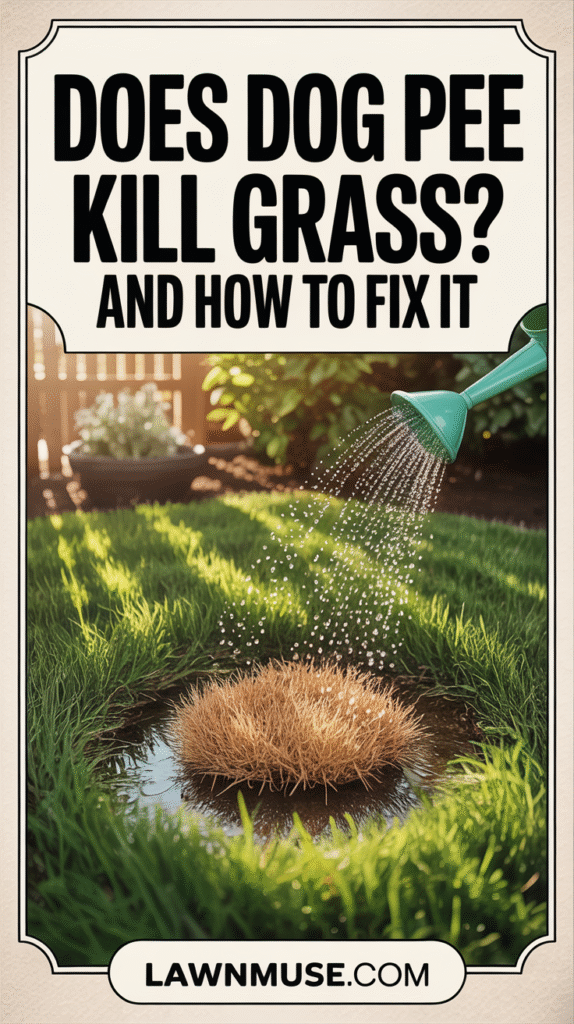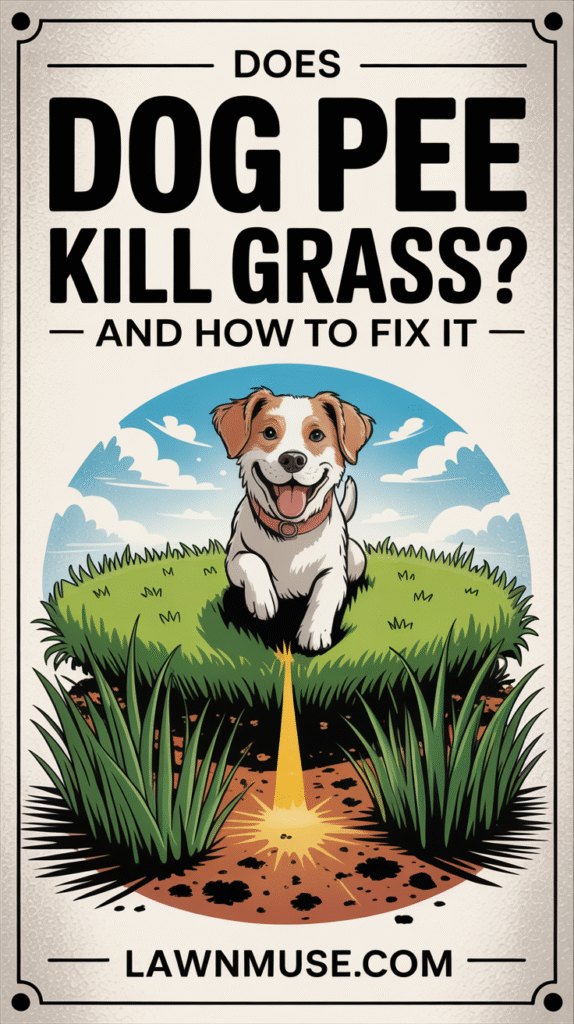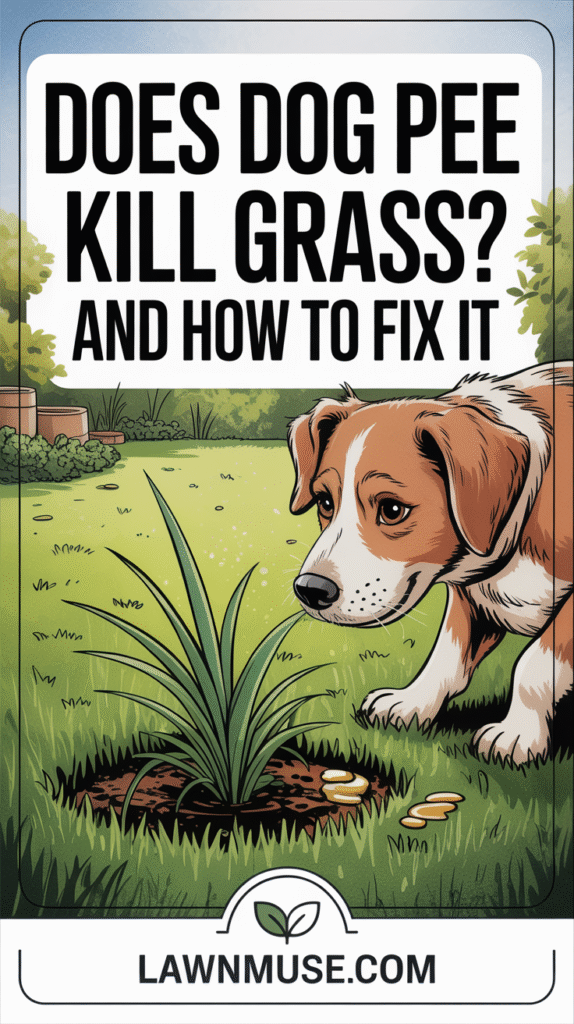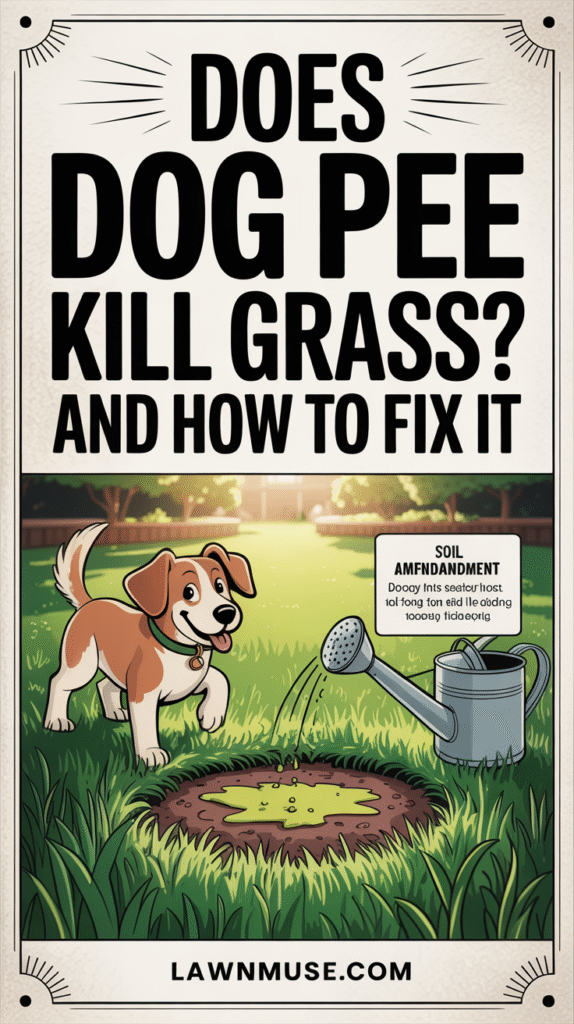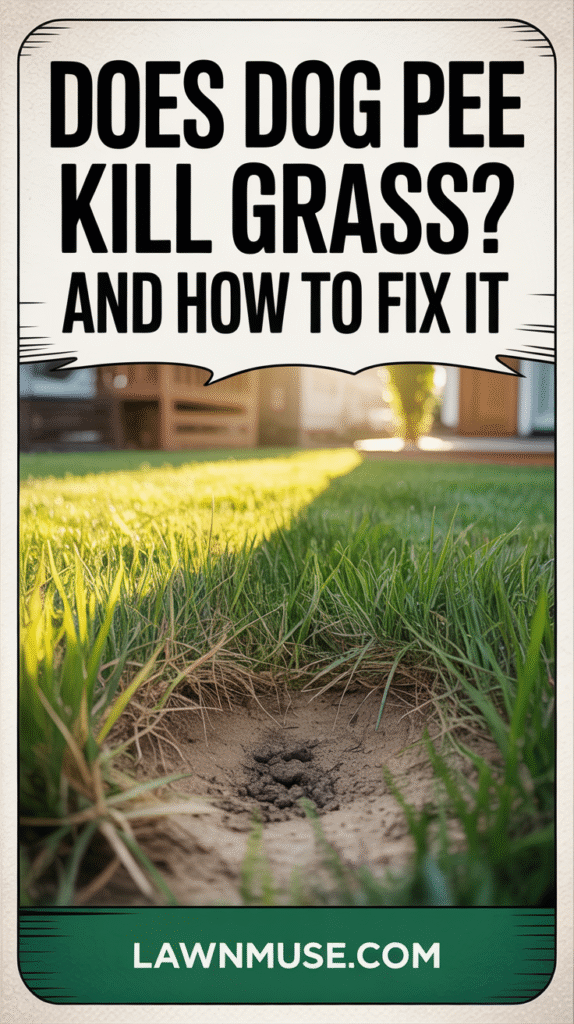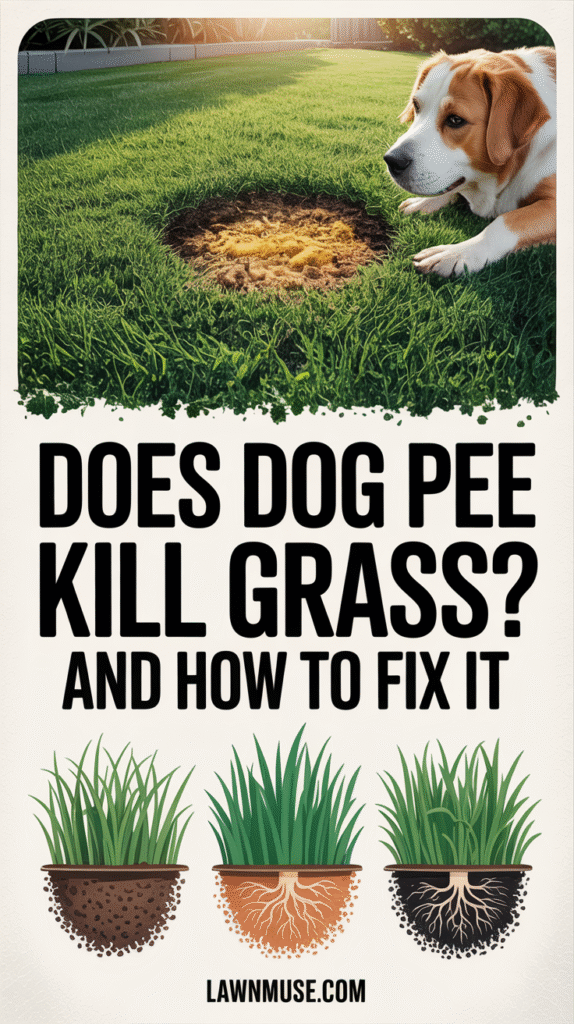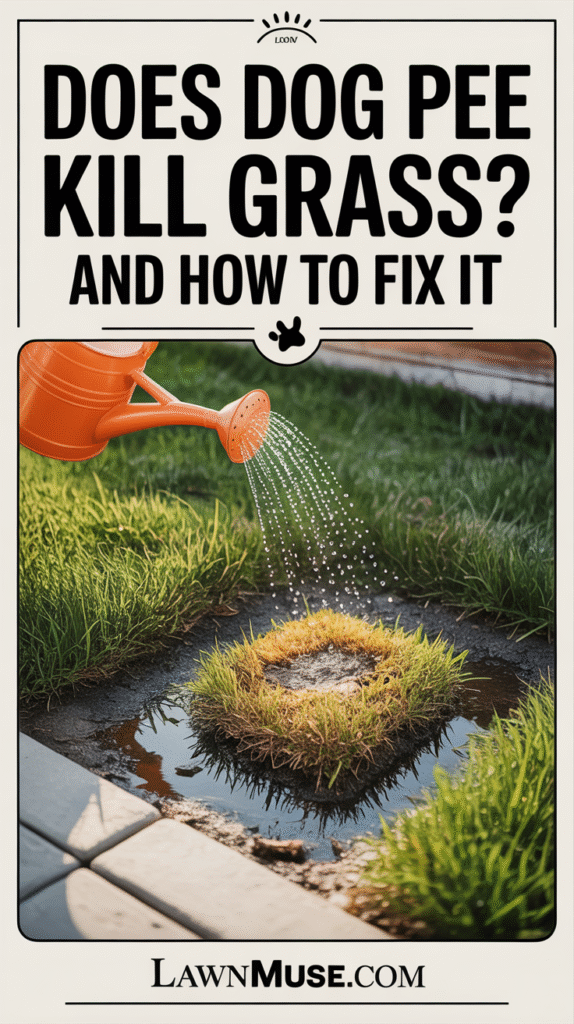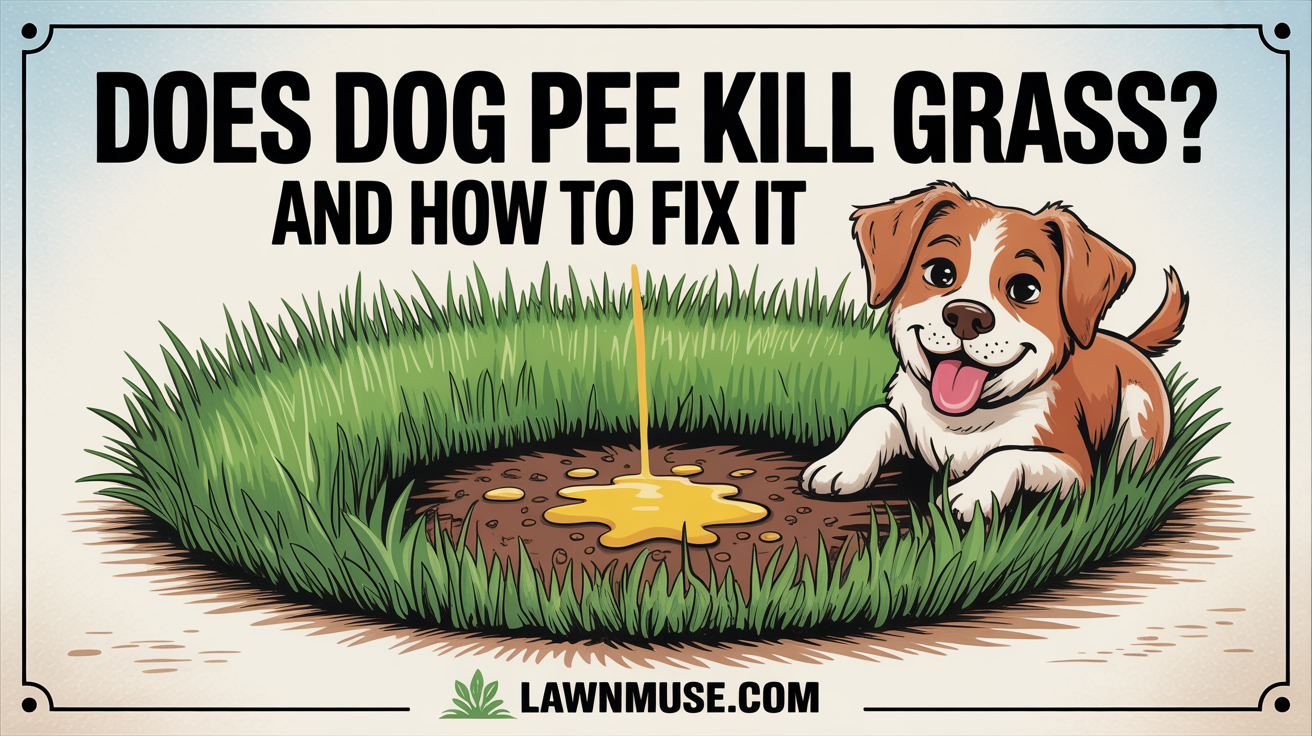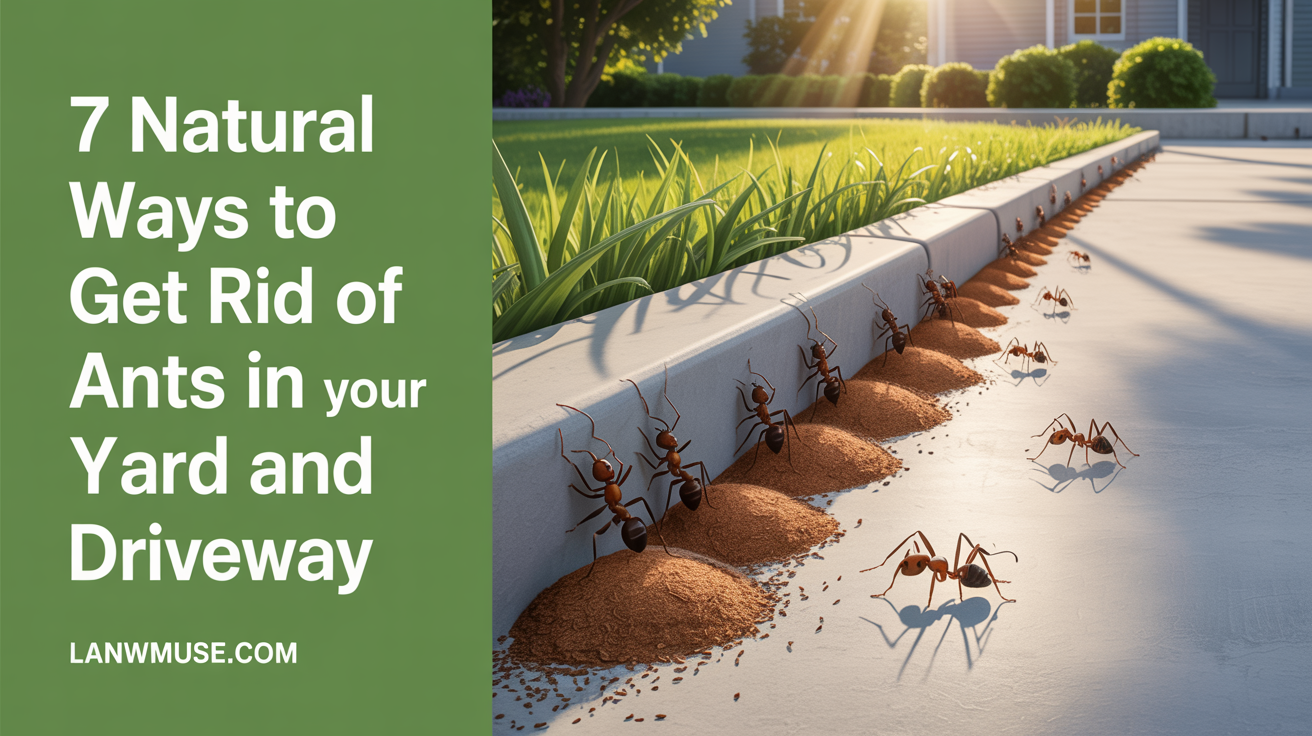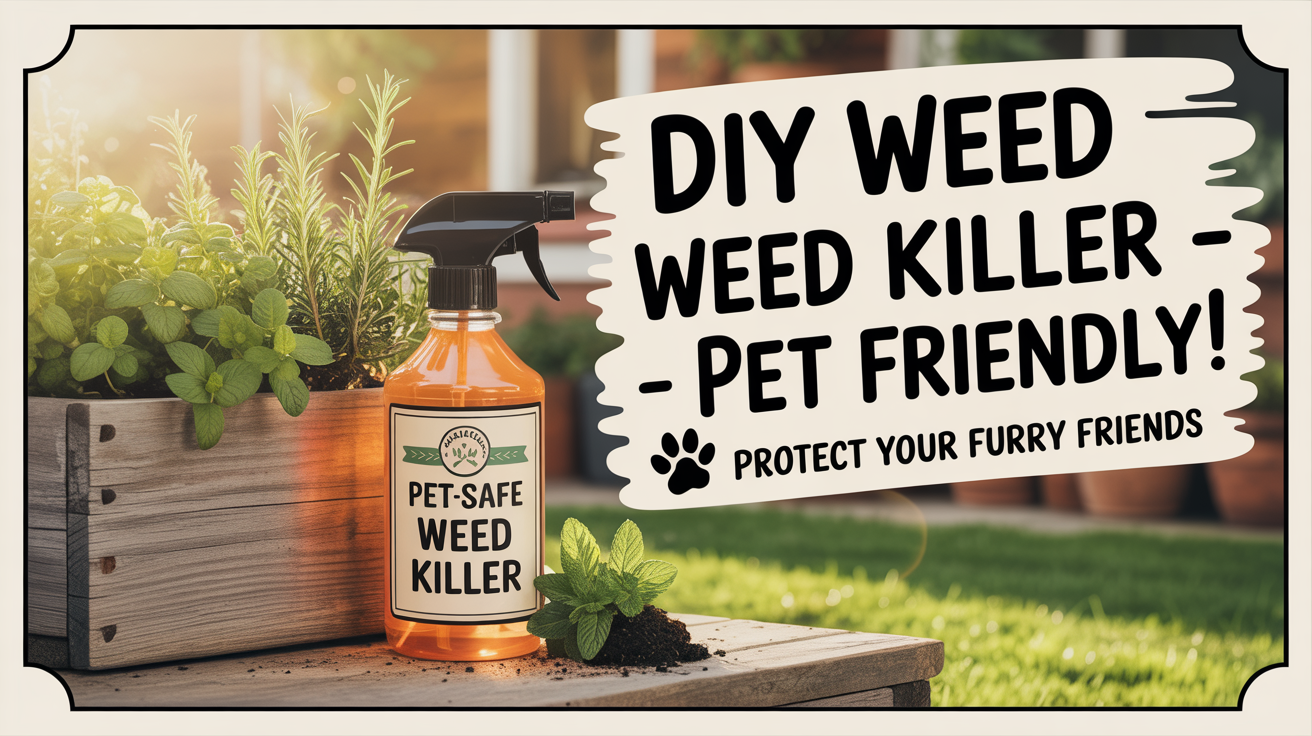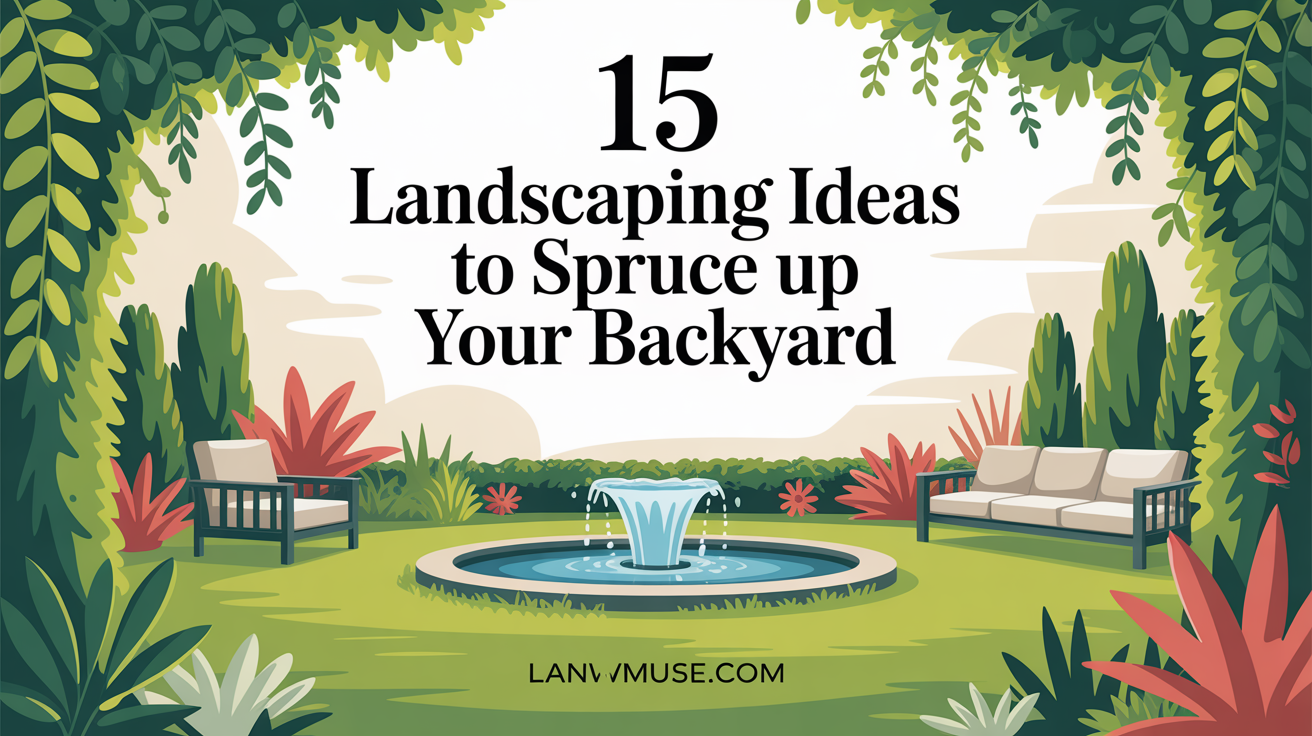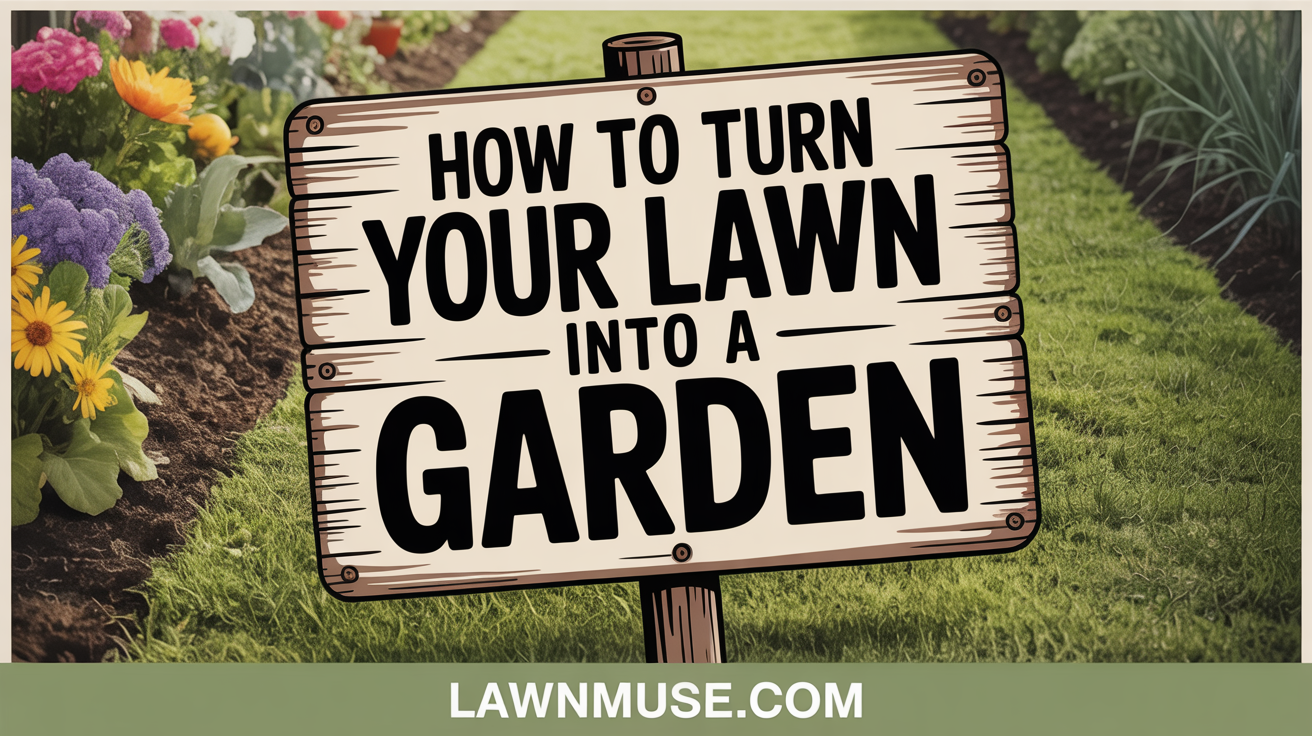You love your furry friend, and you love your lush lawn. But sometimes, those two loves clash, leaving you with frustrating brown or yellow patches in your otherwise perfect yard. Don’t worry, you don’t have to choose between your dog and beautiful grass!
Understanding why dog pee damages your lawn is the first step to fixing the problem. We’ll explore the causes, how to identify different types of damage, and most importantly, how to prevent and repair those unsightly spots.
How Dogs Damage Your Lawn
It’s not just urine that can take a toll on your lawn. Your canine companion, with all their playful energy, can impact your yard in a few key ways.
Damage from Pee
Let’s face it, your backyard is often your dog’s favorite potty spot. The main culprit behind those burned, bare patches? Nitrogen and salts. Dog urine is naturally high in these compounds. While a little nitrogen is great for grass, a concentrated dose acts like an overdose of fertilizer, burning the grass roots and causing it to die.
Damage from Poop
Skipping daily poop pickup isn’t just unpleasant; it can also harm your lawn. Like urine, dog poop contains nitrogen. If left to break down on your grass, it can cause burns. Plus, it can harbor fungal lawn diseases and spread harmful bacteria, posing a risk to your family, other pets, and wildlife.
Damage from Digging
It’s obvious: when your dog digs, they uproot grass. But frequent digging creates long-term issues. Exposed soil dries out quickly and loses vital nutrients, making it harder for new growth to establish.
Damage from Running
Heavy foot traffic, whether from humans or dogs, compacts the soil and smashes grass blades. This compacted soil makes it difficult for grass roots to access the water and nutrients they need. Since dogs often run or walk the same paths, these areas become worn down and can even die. A helpful tip for soil compaction is to aerate your lawn annually.
How to Identify Dog Urine Damage in Grass
Spotting dog pee damage isn’t always straightforward, as other issues can cause similar symptoms. However, urine spots often have distinct characteristics.
Brown Spots
If you see yellowing or brown areas, the grass is dying. If dog urine is the cause, you’ll typically notice a dark green ring around the edge of the dead patch. This happens because the nitrogen is less concentrated further from the center, giving the surrounding grass a fertilizing boost. If the grass doesn’t pull up easily when you tug on it, dog urine is likely the problem, as it doesn’t weaken roots like grubs or fungus.
Green Spots
Sometimes, instead of browning, your dog’s favorite potty spots turn a darker, lusher green than the rest of your lawn. This is a sign that your lawn isn’t getting enough nitrogen overall, so it’s soaking up the nutrients from your dog’s urine. The good news? You can get your whole lawn to that vibrant color by applying a nitrogen-rich fertilizer. Just be aware that once your lawn is well-fed, those urine spots might start turning brown.
Why Dog Pee Kills Grass
The common belief that dog urine kills grass due to acidity is a myth. The real culprit is the high concentration of nitrogen. Dogs’ diets, rich in protein, lead to high levels of urea (a form of nitrogen) in their urine. While nitrogen is a key fertilizer, too much in one small area will burn and kill grass.
Does a Dog’s Diet Affect Urine Damage to Your Lawn?
Yes, it can. Processed proteins in dog food, common in many dry and wet kibbles, create more urea and thus higher nitrogen content in urine than fresh proteins. This means dogs on highly processed diets might cause more lawn damage. If you’re considering altering your dog’s diet, always talk to your veterinarian first.
Does a Dog’s Water Intake Affect Urine Damage to Your Lawn?
Absolutely. The more water your dog drinks, the more diluted the nitrogen in their urine will be. This dilution reduces the concentration of nitrogen and salts, lessening the potential for lawn damage. Keeping fresh water available in multiple bowls or adding water to their food can encourage better hydration.
Does a Dog’s Gender Affect Urine Damage to Your Lawn?
No, this is a common misconception. The chemical makeup of urine is the same for male and female dogs. The difference in lawn damage often comes down to how they urinate. Female dogs tend to squat and release all their urine in one concentrated spot, leading to more noticeable damage. Many male dogs, especially when marking territory, spread smaller amounts of urine over a larger area, which can cause less concentrated damage. Any dog that squats, regardless of gender, can cause concentrated damage.
Does a Dog’s Breed Affect Urine Damage to Your Lawn?
Not at all. Your dog’s breed has no direct impact on whether their urine will damage your grass. Individual factors, rather than breed, account for differences in lawn impact.
What Makes a Grass Type Good for Dogs?
Choosing the right grass type for your climate and your dog’s habits can make a big difference.
Rapid Growth Rate
A quick-growing grass is beneficial because it helps the lawn recover on its own, even if your dog creates a bare spot. Grasses that spread laterally using rhizomes or stolons are ideal, as they can naturally fill in damaged areas without needing to be reseeded.
Deep Root System
Grasses with deep, thick roots are generally more durable. A denser root system makes the grass more resilient to daily wear and tear, including frequent urination and rolling. Strong roots also make it harder for your dog to dig them up and access the soil.
Climate Compatibility
Selecting a grass that thrives in your local climate is crucial. Grass that is not suited for its environment will already be weak and susceptible to damage. The United States has three main climate zones for grass:
- Cool-season zone: Northern parts of the country.
- Transition Zone: The central part of the country, supporting both cool-season and warm-season grasses.
- Warm-season zone: Southern parts of the country. Always consider a grass type’s preferred sun exposure, soil conditions, and maintenance needs when making your choice.
Best Grasses for Dogs
Here’s a breakdown of some of the best dog-friendly grass varieties, categorized by their preferred climate.
Cool-Season Grasses
These grasses prefer temperatures between 60 to 75 degrees Fahrenheit. They grow actively in early spring and early fall and can maintain their green color through summer and winter in transition zones. They often require more fertilizer and pesticides than warm-season types.
- Tall Fescue: This is a hardy, drought-resistant, and shade-tolerant option. Its deep roots help it withstand heavy foot traffic, high temperatures, and daily wear. Tall fescue has a bunch-type growth habit, meaning it doesn’t spread on its own, so you might need to reseed damaged spots. Look for newer “turf-type” tall fescue (TTTF) cultivars for a stronger lawn.
- Kentucky Bluegrass: A top-tier turfgrass known for its high foot traffic tolerance and quick recovery from injury. Unlike tall fescue, it spreads by rhizomes, allowing it to self-repair damaged areas. While it takes time to establish, once it’s set, it grows quickly. It has a soft texture, which your dog will love. It prefers full sun and has moderate drought tolerance, going dormant to survive dry periods. It has moderate to high disease potential and high fertilization needs.
- Perennial Ryegrass: This grass thrives in coastal climates and mild year-round temperatures. It handles high traffic and wear well, making it perfect for active dogs. However, it’s a bunch-type grass and won’t self-heal bare spots. It’s also less tolerant of heat, shade, or drought. Perennial ryegrass germinates quickly, making it an excellent choice for reseeding dead patches caused by urine or digging. It mixes well with other grass types.
Warm-Season Grasses
These varieties thrive in temperatures between 80 to 95 degrees Fahrenheit and are best suited for the Southern United States. They begin active growth in spring and go dormant in early to mid-fall. Warm-season grasses are generally drought- and heat-tolerant but can’t handle frost or extreme cold.
- Bermudagrass: Thanks to its dense roots, Bermudagrass can handle heavy wear and tear from dogs. It’s highly drought-tolerant and can survive salty conditions, making it great for coastal areas. It spreads rapidly via stolons and rhizomes, allowing it to recover quickly from damage. However, it needs full sun and is considered high-maintenance, requiring frequent mowing, watering, and fertilizing.
- Centipedegrass: This warm-season grass boasts high heat tolerance, bright green foliage, and a dense growth habit. Its high watering needs mean dog urine is easily diluted, minimizing damage. It’s also low-maintenance, disease- and pest-resistant, and doesn’t require frequent mowing, dethatching, or heavy feeding. It spreads by stolons. Keep in mind it has low to moderate drought resistance and low foot traffic tolerance.
- Zoysiagrass: Drought- and heat-tolerant, Zoysiagrass has a deep root system that also makes it more cold and shade-resistant than other warm-season options. It creates a dense, dark-green lawn that can shield the soil from urine damage. It spreads by both rhizomes and stolons, allowing it to fill in dog-related dead patches on its own. However, it establishes slowly and, once established, can have a stiff, prickly texture. Its dense growth can lead to excessive thatch buildup, requiring regular dethatching.
How to Stop and Repair Dog Urine Damage in Your Lawn
Preventing and repairing dog urine damage is totally achievable with a bit of effort and consistency.
Prevention Strategies
- Dilute the Urine Immediately: This is one of the most effective methods. As soon as your dog finishes peeing, use a hose or watering can to thoroughly flush the spot. This dilutes the nitrogen and salts, preventing the grass from burning.
- Designate a Pee Spot: Train your dog to use a specific, non-turf area in your yard for their business. This area can be covered with mulch, gravel, or even artificial turf. Reward your dog when they use this spot to reinforce the habit. This is truly the most reliable solution.
- Increase Your Dog’s Water Intake: Encourage your dog to drink more water. The more diluted their urine, the less concentrated the nitrogen will be, reducing the risk of burns.
- Adjust Lawn Fertilization: If you notice green spots (indicating nitrogen deficiency in the rest of your lawn), increase your overall lawn fertilization. However, if you know certain areas get regular dog urine, consider reducing nitrogen fertilizer in those specific spots, as the urine will provide what’s needed.
- Use Lawn Treatments/Soil Amendments: There are products designed to help. Soil amendments containing beneficial bacteria can help the soil metabolize excess nitrogen from urine. Some repair kits also include soil amendments to neutralize salts.
- Raise Your Mowing Height: Keeping your grass a little longer can make it less sensitive to urine damage.
- Consider Dietary Adjustments (with Vet Guidance): While not a guaranteed fix, some believe that feeding a raw or less processed diet can reduce nitrogen in urine. However, exercise extreme caution with enzyme supplements that claim to alter urine chemistry, as they can be harmful to your dog’s health and lack scientific evidence of effectiveness. Always consult your veterinarian before adding any supplements to your dog’s diet.
Repairing Brown Spots
Once grass turns brown from urine, it’s typically dead and won’t come back to life. But you can easily repair these spots!
- Water Deeply: First, thoroughly water the brown area to dilute any remaining salts in the soil. This prepares the soil for new growth.
- Remove Dead Grass: Clear out all the dead grass from the affected area. For severe damage, you might need to remove the top 0.5-1 inch of soil.
- Reseed: Repair the spot by reseeding with new grass. Many all-in-one patching products are available that combine seed, fertilizer, and mulch.
- For Kentucky bluegrass lawns, you can spot seed with Kentucky bluegrass or perennial ryegrass.
- For tall fescue lawns, use turf-type tall fescue or perennial ryegrass.
- For fine fescue lawns, use fine fescue seed.
- For Zoysiagrass and Bermudagrass, patching with sod from a sod farm or an inconspicuous area of your own lawn is often best.
- Protect New Growth: Keep pets and people off newly seeded areas until the grass is well-established, usually after 3-4 mows.
Other Dog-Friendly Landscaping Ideas
Beyond grass selection and spot repair, you can make your entire yard more dog-friendly and durable:
- Kiddy Pool: Set up a small pool for your dog to cool off in during hot weather.
- Flea-Repelling Plants: Plant herbs and other plants known to repel fleas.
- Sandbox for Digging: If your dog loves to dig, create a designated sandbox for them. Hide toys in it to encourage them to dig there instead of your lawn.
- Install a Path: Create a path or walkway in areas of high dog traffic to prevent grass wear.
Your new damage-resistant grass is a fantastic start to a dog-friendly landscape. With these strategies, you, your dog, and your lawn can all live happily ever after!
Frequently Asked Questions
What grass type is the most urine-resistant?
Generally, warm-season grasses tend to recover better from dog urine damage. However, among cool-season grasses, tall fescue is often considered the most urine-resistant. Centipedegrass is also a good option due to its high watering needs, which helps dilute urine.
Will my dog get sick if they eat grass?
Many dogs enjoy munching on grass. While some dogs may do it for digestive reasons, it can also lead to health problems for others. It’s always a good idea to monitor your dog’s reaction to eating grass and consult your vet if you have concerns.
Is artificial grass an option if I have a dog?
Yes, artificial grass is considered safe for dogs. Manufacturers typically put their products through rigorous tests to ensure they are free of harmful substances. If you’re considering artificial grass, ask about certifications for peace of mind.
Will grass grow back after dog urine damage?
It depends. If the grass is only yellowing, increased watering might save it before it completely dies. However, if the grass is brown, it is dead and won’t revive. New grass can grow in its place through reseeding or, if the grass type spreads by rhizomes or stolons, the surrounding healthy grass may gradually fill in the spot.
Does lime neutralize dog urine?
Yes, garden lime can help neutralize dog urine. Dog urine can alter the soil’s pH due to its salt content, making it too acidic or alkaline. Applying garden lime helps stabilize the soil’s pH, creating a healthier environment for grass.
Will baking soda neutralize dog urine on grass?
No, baking soda is not recommended to neutralize dog urine on grass and can actually cause more harm than good. While it might help remove odor, applying it to your lawn won’t neutralize the urine’s effects. The best “product” to neutralize urine’s negative effects is simply water.
Do brown spots in the lawn mean my dog is sick?
Not necessarily. Urine from a healthy dog can cause brown spots just as easily as urine from a sick dog. However, if you notice any unusual changes in your dog’s bathroom habits, it’s always a good idea to have your vet check them out, especially for kidney health.
